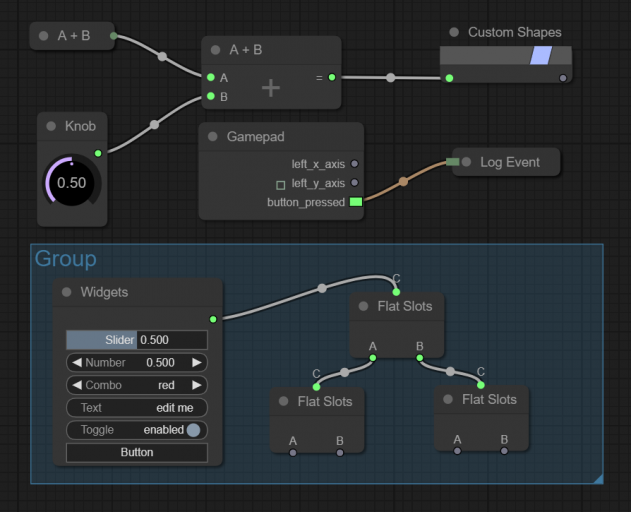litegraph.js
nodes can be programmed easily and it includes an editor to construct and tests the graphs. It can be integrated easily in any existing web applications and graphs can be run without the need of the editor.
Features
- Renders on Canvas2D (zoom in/out and panning, easy to render complex interfaces, can be used inside a WebGLTexture)
- Easy to use editor (searchbox, keyboard shortcuts, multiple selection, context menu, ...)
- Optimized to support hundreds of nodes per graph (on editor but also on execution)
- Customizable theme (colors, shapes, background)
- Callbacks to personalize every action/drawing/event of nodes
- Subgraphs (nodes that contain graphs themselves)
- Live mode system (hides the graph but calls nodes to render whatever they want, useful to create UIs)
- Graphs can be executed in NodeJS
- Highly customizable nodes (color, shape, slots vertical or horizontal, widgets, custom rendering)
- Easy to integrate in any JS application (one single file, no dependencies)
- Typescript support
examples video: http://github.com/jagenjo/litegraph.js
Nodes provided
Although it is easy to create new node types, LiteGraph comes with some default nodes that could be useful for many cases:
- Interface (Widgets)
- Math (trigonometry, math operations)
- Audio (AudioAPI and MIDI)
- 3D Graphics (Postprocessing in WebGL)
- Input (read Gamepad)
Installation
You can install it using npm
npm install litegraph.js
Or downloading the build/litegraph.js and css/litegraph.css version from this repository.
First project
<html>
<head>
<link rel="stylesheet" type="text/css" href="litegraph.css">
<script type="text/javascript" src="litegraph.js"></script>
</head>
<body style='width:100%; height:100%'>
<canvas id='mycanvas' width='1024' height='720' style='border: 1px solid'></canvas>
<script>
var graph = new LGraph();
var canvas = new LGraphCanvas("#mycanvas", graph);
var node_const = LiteGraph.createNode("basic/const");
node_const.pos = [200,200];
graph.add(node_const);
node_const.setValue(4.5);
var node_watch = LiteGraph.createNode("basic/watch");
node_watch.pos = [700,200];
graph.add(node_watch);
node_const.connect(0, node_watch, 0 );
graph.start()
</script>
</body>
</html>
How to code a new Node type
Here is an example of how to build a node that sums two inputs:
//node constructor class
function MyAddNode()
{
this.addInput("A","number");
this.addInput("B","number");
this.addOutput("A+B","number");
this.properties = { precision: 1 };
}
//name to show
MyAddNode.title = "Sum";
//function to call when the node is executed
MyAddNode.prototype.onExecute = function()
{
var A = this.getInputData(0);
if( A === undefined )
A = 0;
var B = this.getInputData(1);
if( B === undefined )
B = 0;
this.setOutputData( 0, A + B );
}
//register in the system
LiteGraph.registerNodeType("basic/sum", MyAddNode );
or you can wrap an existing function:
function sum(a,b)
{
return a+b;
}
LiteGraph.wrapFunctionAsNode("math/sum",sum, ["Number","Number"],"Number");
Server side
It also works server-side using NodeJS although some nodes do not work in server (audio, graphics, input, etc).
var LiteGraph = require("./litegraph.js").LiteGraph;
var graph = new LiteGraph.LGraph();
var node_time = LiteGraph.createNode("basic/time");
graph.add(node_time);
var node_console = LiteGraph.createNode("basic/console");
node_console.mode = LiteGraph.ALWAYS;
graph.add(node_console);
node_time.connect( 0, node_console, 1 );
graph.start()

